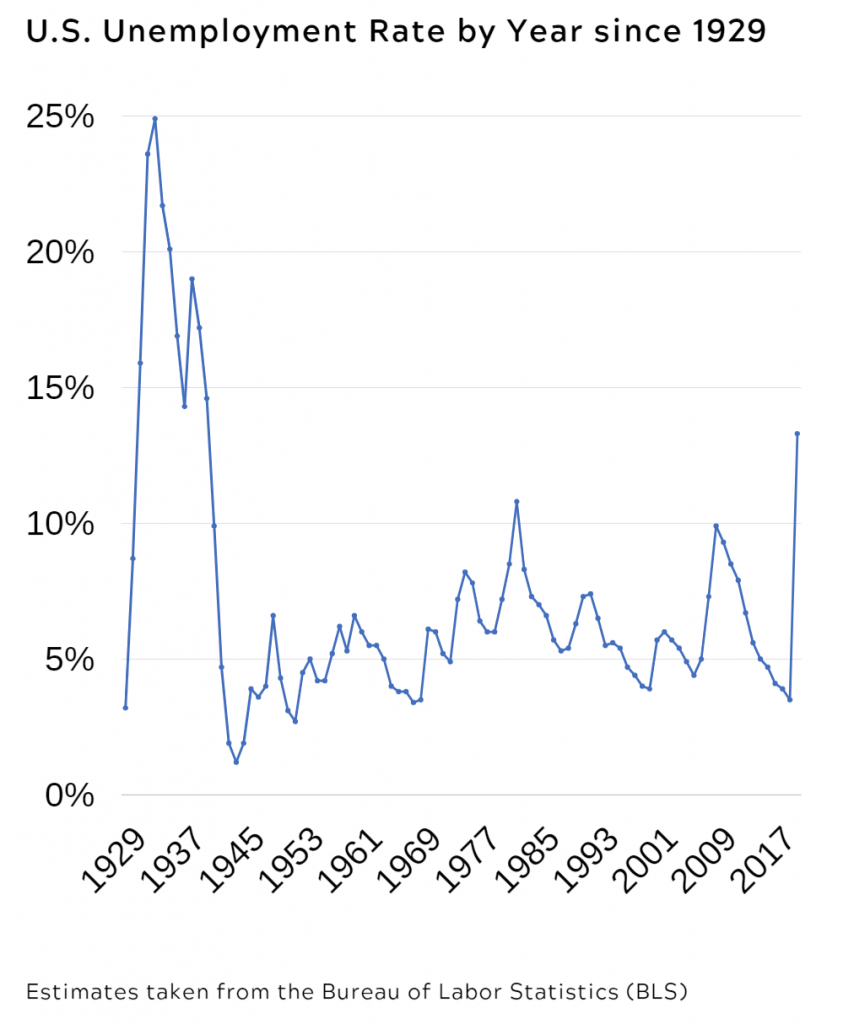Centering on Coronavirus: Could Germany’s Kurzarbeit Come to America?

In late 2019, the U.S. unemployment rate was the lowest it had been in 50 years.
By May 2020, it was 13.3%, the highest level since the Great Depression.
At least 20 million jobs have been lost since the onset of the COVID-19 crisis, and millions more people are working reduced hours.
To their credit, Congress, the U.S. Treasury Department, and the Federal Reserve have marshalled an unprecedented, multi-trillion dollar response to this economic and employment crisis. This included measures to shore up financial and credit markets, loans and grants to small businesses, as well as targeted relief to workers and families with a direct $1,200 stimulus check, and an expansion of unemployment benefits to include an additional $600 each week from the federal government.
And yet a question must be asked:
Shouldn’t this historic government response from Washington buy us something better than the worst unemployment crisis since the 1930s, with millions of workers unsure when or if they’ll be able to go back to their old jobs?
It should, and it could, if America was committed to a more robust program to keep workers connected to their jobs. Like, for example, in Germany, whose response to the economic crisis brought about by the COVID-19 pandemic has largely relied on a program called Kurzarbeit. Translated as “short-time work,” this government program directly pays workers 60-70% of their salary while maintaining their employment status during periods of reduced working time. This alternative furlough scheme has proven successful in reducing unemployment in previous economic crises and is doing so once again now.
In Germany, the unemployment rate as of May 2020 was 6.3%, significantly lower than the 13.3% rate experienced in the U.S. Even though some of that disparity can be explained by Germany being able to more effectively stem the spread of COVID-19 and avoid the ruinous lockdowns that were required in the U.S., Kuzarbeit has unquestionably played a role in helping prevent layoffs of German workers. Other European countries, including the UK, Denmark, and the Netherlands, have implemented similar models after recognizing Germany’s success in recovering from the 2008 recession.
In this paper, The New Center explores how the U.S. might embrace a Kurzarbeit-like program to protect American jobs in future recessions.

How does the Kurzarbeit program work?
The Kurzarbeit program has existed in some form since the early 1900s but was significantly expanded in the aftermath of the 2008 recession. In the wake of that financial crash, Germany’s unemployment rate peaked at 7.9%, compared to the U.S. where it reached as high as 10.6%. Having saved nearly half a million jobs in Germany during the 2008 recession, according to OECD estimates, millions more jobs could be saved during the COVID-19 pandemic thanks to the program.
Under the German Kurzarbeit program, when working hours are reduced due to economic shock, employers can apply for the program in order for their employees to receive partial compensation of their wages or salary (typically 60-70%). All other hours worked are paid as usual by the respective employer. The principle underlying Kurzarbeit is simple: It’s often better for a company and its workers to maintain the job status of their current employees rather than cutting ties altogether. Employers can avoid incurring the cost of hiring and training new workers, and employees can avoid facing the financial losses and stresses of unemployment. The Kurzarbeit program acts as an automatic stabilizer, kicking in when it is needed and phasing out quickly when economic conditions improve.
As part of its response to the COVID-19 pandemic, Germany expanded the Kurzarbeit program further and made it easier for businesses to access the support. Companies can now receive funding from the program when just ten percent of their workforce have been given reduced working hours, as opposed to the previous requirement of 30%. Since the onset of the COVID-19 epidemic, half of all German firms have applied to put some or all of their employees on the reduced working hours scheme of the Kurzarbeit program. The Ifo Institute in Germany found that 99% of restaurants, 97% of hotels, and 94% of companies in the auto sector are making use of the Kurzarbeit program. Those same industries in the U.S. have been acutely impacted by the pandemic, such as the foodservice industry, which has an unemployment rate reaching as high as 32.3%. The German government expects up to 2.35 million people to receive wage support from the Kurzarbeit program due to the COVID-19 pandemic, costing the country approximately €10 billion ($11.1 billion).
How does Kurzarbeit compare to the U.S. response to recession?
In the U.S., unemployment benefits are more generous than they’ve ever been thanks to the Pandemic Unemployment Assistance (PUA) provision included in the CARES Act, which offers recipients an additional $600 from the federal government on top of the state unemployment benefits they are already receiving. The PUA is estimated to have covered half of all lost private wages and salaries in April 2020. But it has also led to the largest monthly jump in total unemployment insurance payments in over 60 years, and with a monthly payment total three times higher than the monthly peak experienced during the 2008 recession. Continued support for workers impacted by the crisis is of the utmost importance; however, our current model is both costly and temporary, with the expanded weekly benefit set to expire by July 31, 2020.
Typically, unemployment benefits cover between 30-55% of workers’ previous income, also known as the replacement rate. Some workers receiving unemployment benefits amid the COVID-19 pandemic, however, are earning more than their total previous income. A recent study from the University of Chicago found that an estimated 68% of unemployed workers eligible for benefits would actually suffer income losses by returning to work. Unemployment benefits of this magnitude can disincentivize people to get back to work, making an economic recovery that much more difficult. For example, in a recent Bipartisan Policy Center-Morning Consult survey, nearly a third of small businesses said that expanded unemployment benefits made it more difficult to retain their employees.
Unemployment programs on the state level also vary widely in their efficiency and effectiveness. Many states have struggled to handle the dramatic increase in unemployment filings made during the COVID-19 pandemic, and putting the burden on the unemployed to navigate these overwhelmed systems has left many without access to the help they need. According to a Washington Post-Ipsos poll in May 2020, 60% of laid-off workers reported trying to apply for unemployment benefits, but only 28% had received any benefits. The major reason for failure to receive benefits was due to technical issues such as busy phone lines or website malfunction. These problems have afflicted unemployed workers of every demographic, but black workers in particular, who have been laid off at higher rates than white Americans during the pandemic, and haven’t seen the same level of improvement in the employment rate as indicated in the May 2020 jobs report.
Clearly the U.S. system for dealing with economic shocks can be unwieldy and inefficient even during a run-of-the-mill recession, but it is particularly ill-equipped to handle unemployment during a crisis of this magnitude.
However, Germany’s Kurzarbeit program—for all its virtues—does have some real drawbacks. One issue is the potential for keeping people linked to “zombie jobs,” which are jobs that simply may not be necessary in whatever new economy emerges on the other side of this virus. For example, the airline and cruise industry may simply need to be smaller for the foreseeable future to account for the fact that they’ll have fewer customers. Some workers in these industries might be better served moving to employment in a different industry with better employment prospects. Despite these concerns, however, the much more immediate economic threat is long-term unemployment. A U.S. program modeled after Kurzarbeit could provide a meaningful solution.
New Center Solution: Kurzarbeit Comes to the U.S.
Is there bipartisan support for a Kurzarbeit-type program in the U.S.?
The short answer is yes.
The longer answer is that the details—like the size and scope of the program and the generosity of its benefits—would ultimately determine if it could get real momentum in Congress.
Representative Pramila Jayapal (D-WA), a member of the Progressive Caucus, has recently introduced the Paycheck Recovery Act, which is modeled after the Kurzarbeit program and would cover the full wage of workers up to $90,000 while also ensuring employers can rehire those laid off or furloughed since March 1, 2020. The program would utilize existing payroll tax infrastructure rather than relying on banks or lending institutions to distribute the direct grants. According to her office it is estimated to cover more than 36 million workers and cost less than what has already been spent on two rounds of the Paycheck Protection Program (PPP) loans, although this estimate has not been verified by a nonpartisan outside source like the Congressional Budget Office.
While Representative Jayapal’s specific bill has not yet attracted bipartisan support, many economic thinkers on the right do support the concept of a Kurzarbeit-like program in the U.S. For example, Michael Strain, the director of economic policy studies at AEI, has stated that such a program “would help the economy recover faster from the pandemic by keeping the unemployment rate lower than it would otherwise be and [also] mitigate the prevalence of long-term unemployment, and the financial, social and psychological devastation that accompanies it.” The conservative-leaning Tax Foundation has also noted the potential benefit of using a short-time work program to “provide relief to both workers and businesses considerably affected by the crisis.” Kevin Hassett, a senior economic advisor to President Trump, advocated for creating a short-time work program back in 2009 in response to the financial recession, suggesting that “fewer workers would be stigmatized by being laid off, significantly reducing chances that long-term unemployment skyrockets.”
Many Republicans in Congress also publicly support the basic idea of having the federal government provide incentives to keep people working or get people back to work. For example, in his recently introduced Reopening America by Supporting Workers and Businesses Act, Representative Kevin Brady (R-TX) proposed a back-to-work bonus that would pay workers an additional two weeks of supplemental federal unemployment benefits, equivalent to $1,200, after accepting a job.
Versions of short-time work programs already exist in 26 U.S. states, allowing employers to opt in so employees can receive unemployment benefits for lost hours. However, the number of companies using these programs so far has been limited. According to Betsey Stevenson, former chief economist of the Department of Labor, the major limitation preventing their widespread adoption has been a lack of awareness of these programs compared to companies in Europe. Additionally, these programs are much more limited in scope and accessibility due to their lower compensation benefits and their varied work-hour requirements.
With expanded unemployment benefits set to expire by July 31, 2020, there is ample opportunity for discussion and bipartisan negotiation around creating a more sustainable and effective program that protects American jobs and helps people get back to work.
